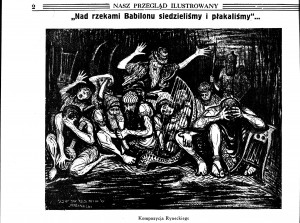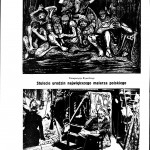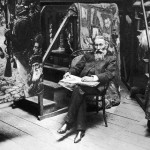 I really, really, wish I could explain what it’s like to get an email that says, “I’m sending you images and links….have you seen these images?” There’s palpable excitement in the moment before I get to actually see the image – my heart beats faster, my hand moves towards the cursor to click on the link or download the image… Will it be something I’ve seen before? Will it actually BE a Moshe Rynecki painting? Will I recognize the style? Will I know the subject? And then I open the file and it is, in fact, an image I have NOT ever seen before, and yet there is the immediate recognition of the style – the look and feel of my great-grandfather’s approach to painting and composition. There’s an incredible euphoric feeling of the discovery of a piece I had not previously known was out there and the instinct to immediately share it. First I send it off to my father (Moshe’s grandson), then I tell my husband and sons about it, and I have several friends who I share it with in an email, and then I upload it to my website, and then I post it here. Sometimes I struggle to do all those things all at once. A discovery must always be shared with others! It’s what the Chasing Portraits story is all about. I have a line in a grant proposal I recently wrote which says, “This is a story of frustration, hope, and fear, and not one that is easily revealed. But the chase is neither hopeless nor quixotic: I have found dozens of lost works, and have evidence that at least dozens remain to be found.” Today is one of those days where I am ecstatic that I continue to search because today proves that if I keep looking, keep asking for help, keep making my cause known, I *will* find more paintings, I will learn more about my great-grandfather’s oeuvre of work, and I will better understand his art legacy. Thank you for being here so that I may share it with you. The piece here today is the one that is new to me this morning. It is titled, “By the Rivers of Babylon we sat and wept.” It was printed in 1938 in Nasz Przeglad Ilustrowany, no 32, page 2.
I really, really, wish I could explain what it’s like to get an email that says, “I’m sending you images and links….have you seen these images?” There’s palpable excitement in the moment before I get to actually see the image – my heart beats faster, my hand moves towards the cursor to click on the link or download the image… Will it be something I’ve seen before? Will it actually BE a Moshe Rynecki painting? Will I recognize the style? Will I know the subject? And then I open the file and it is, in fact, an image I have NOT ever seen before, and yet there is the immediate recognition of the style – the look and feel of my great-grandfather’s approach to painting and composition. There’s an incredible euphoric feeling of the discovery of a piece I had not previously known was out there and the instinct to immediately share it. First I send it off to my father (Moshe’s grandson), then I tell my husband and sons about it, and I have several friends who I share it with in an email, and then I upload it to my website, and then I post it here. Sometimes I struggle to do all those things all at once. A discovery must always be shared with others! It’s what the Chasing Portraits story is all about. I have a line in a grant proposal I recently wrote which says, “This is a story of frustration, hope, and fear, and not one that is easily revealed. But the chase is neither hopeless nor quixotic: I have found dozens of lost works, and have evidence that at least dozens remain to be found.” Today is one of those days where I am ecstatic that I continue to search because today proves that if I keep looking, keep asking for help, keep making my cause known, I *will* find more paintings, I will learn more about my great-grandfather’s oeuvre of work, and I will better understand his art legacy. Thank you for being here so that I may share it with you. The piece here today is the one that is new to me this morning. It is titled, “By the Rivers of Babylon we sat and wept.” It was printed in 1938 in Nasz Przeglad Ilustrowany, no 32, page 2.
A special thank you to Piotr Nazaruk for tracking it down and sending it to me this morning.
10 December 2014 – A follow up to the above post.
I posted the above paragraph on Facebook as well, but I also posted a full image of the page from Nasz Przeglad Ilustrowany that features this Rynecki painting. There was some confusion on Facebook about the full page because it features another image as well and I was asked if it was my great-grandfather’s work as well. It is not. I am posting the full page here as well as some further information about the second image that was given to me by Piotr Nazaruk (a friend of the Chasing Portraits project). Piotr wrote, “The bottom image is a photo, in fact – a photo of very important polish artist. Top caption: “100th anniversary of the birth of the greatest Polish artist”, bottom caption: “Jan Matejko in his atelier in Kraków”. It’s interesting that “By the Rivers…” by Moshe Rynecki was put on the same page with Matejko – I don’t think it’s a coincidence. Matejko lived and worked during the partitions, Poland did not exist and his focus was to paint Polish kings, important events from history etc to remind his nation about their Polishness and once free homeland, to keep up the spirit of Poles. It seems to me that “By the Rivers of Babylon we sat and wept” serves for something similar. To remind the Jews about Zion, lost homeland. Works of Matejko were inspired by the desire to reclaim Polish independence. Was Moshe Rynecki inspired by the Zionism? Maybe. The photo was made by photo atielier owned by Juliusz Mien and Józef Sebald in 1891. It’s owned by the National Museum in Kraków. The painting in the background Matejko is working on is “Constitution of May 3, 1791”

